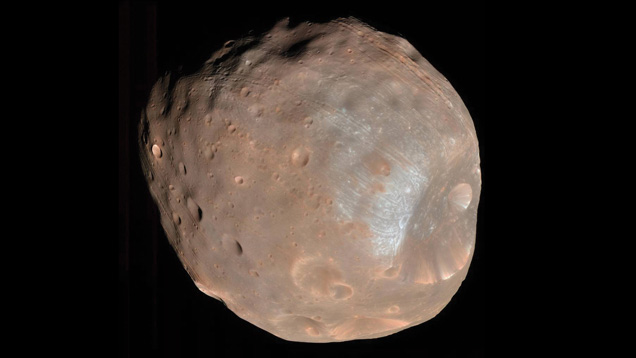Scientific Adventures: Mars' moon is doomed
 CREDIT: NASA
CREDIT: NASAPhobos, one of Mars' tiny moons, is doomed and will likely be shattered due to the relentless tidal forces of Mars' gravitational pull.
This week's newest scientific discoveries make for some exhilarating info to wrap your science-hungry minds around, including a cataclysmic event yet to come and new materials helping the medical world of tomorrow.
Martian moon
In a change of events for the Martian moon, Phobos, scientists are now speculating that the lines across the surface are not being caused by a previous collision, but something much more catastrophic.
Researchers at the NASA Goddard Flight Center now think the lines are proof Phobos is being ripped apart by Mars' gravitational pull.
The damage only continues as Phobos is slowly falling towards the Red Planet, intensifying the damage being done.
NASA researchers stated that the lines on the surface are similar to stretch marks, showing the surface pulling away from itself.
Originally thought to be ancient cracks from a collision ages ago, the new data suggests the lines do not reach from the original impact from crater Stickney, a huge dimple measuring nine kilometres in diameter in the top of Phobos, but instead an area nearby the massive feature.
Terry Hurford said in a NASA press conference that the production of these deep grooves was the first sign of structural failure in the moon. He restated that the popular belief now held by astronomers is that Phobos is a loosely held together pile of space rubble, with an outer cover of regolith about 100 meters thick.
Regolith is the loose rubble and rock that covers solid rock surfaces, essentially the continental topsoil.
Some of the fractures previously hinted at the find, when it was determined that the stress marks across the surfaces had different ages, some drastically younger than others.
Don't worry about the sky falling on Elon Musk's future city though, as officials expect the moon-destroying process to take about 40 million years.
Possible oxygen tank replacement
Researchers at the University of Southern Denmark have created an entirely new compound which could one day cut the need for pressurized oxygen tanks in hospitals, while likening the new material to the oxygen-carrying molecule in our blood, hemoglobin.
The new material is a crystalline matrix, which is composed of cobalt and an organic molecule surrounding the metal, and allows oxygen to bind to it at extremely high concentrations, while also being easily released with no chemical changes.
What's more impressive is that the crystal needs only to be heated or put into oxygen-deprived or a vacuum-like environment to release the oxygen again.
The material was observed taking oxygen out of the air during testing, later being shown to completely remove the oxygen in a standard sized room by using only a teaspoon amount of the substance.
The first use researchers have is in making it easier for hospital patients and users of oxygen therapy to carry around their supply, which is currently in heavy pressurized canisters.
The new crystalline material is able to store up to three times more oxygen than current high-pressure oxygen tanks and can be worked into various materials including breathing masks.
Besides medical uses the scientists also hoped to put the cobalt amalgamation into use for divers, which wouldn't require coming back to the surface as often. This is because oxygen could be pulled from the water into a mask. It could also be used in industrial processes where there needs to be an oxygen deprived environment, or when large amounts of oxygen need to be released quickly.
The researchers are now working on a way to start the oxygen releasing process with light bursts, making the material available for use in the artificial photosynthesis research sector.
One day soon we could see divers stay underwater for days, with only an oxygen mask and some food and medical patients able to move freely through society, not impeded by having to drag around a finite air supply wherever they go.














